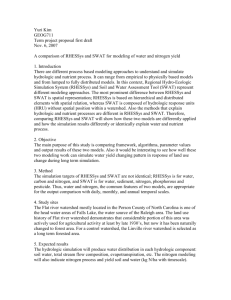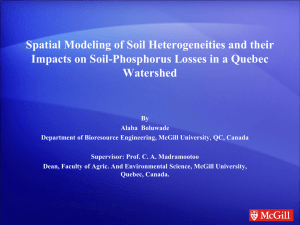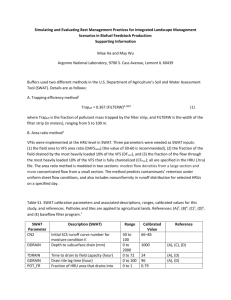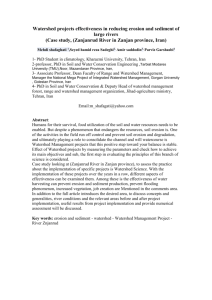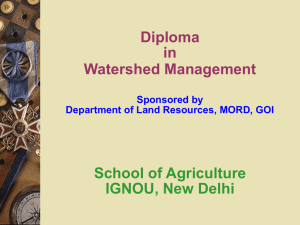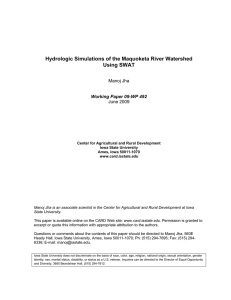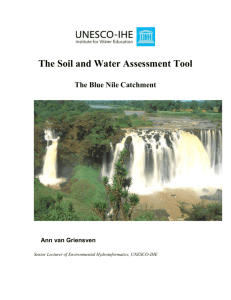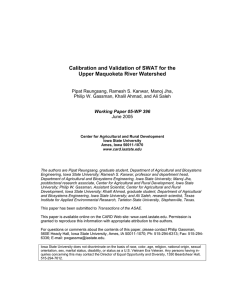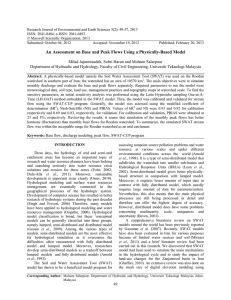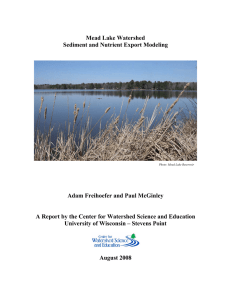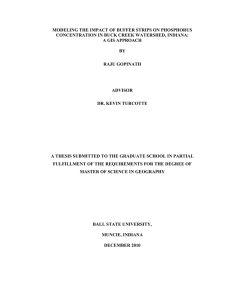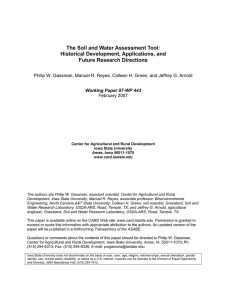References
advertisement
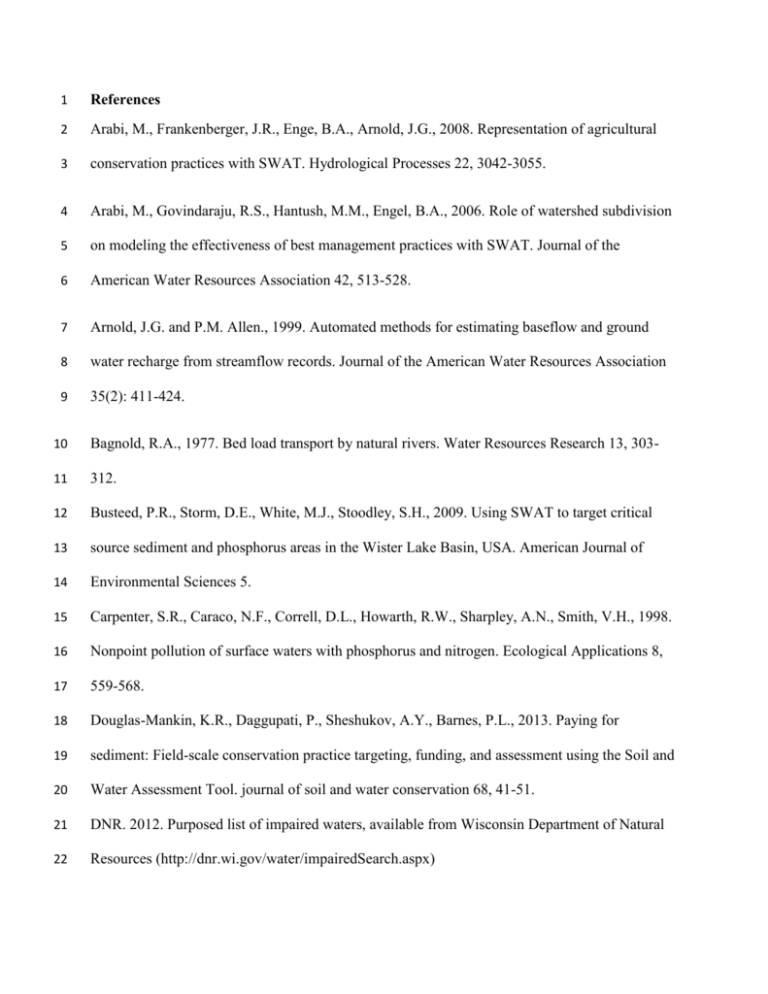
1 References 2 Arabi, M., Frankenberger, J.R., Enge, B.A., Arnold, J.G., 2008. Representation of agricultural 3 conservation practices with SWAT. Hydrological Processes 22, 3042-3055. 4 Arabi, M., Govindaraju, R.S., Hantush, M.M., Engel, B.A., 2006. Role of watershed subdivision 5 on modeling the effectiveness of best management practices with SWAT. Journal of the 6 American Water Resources Association 42, 513-528. 7 Arnold, J.G. and P.M. Allen., 1999. Automated methods for estimating baseflow and ground 8 water recharge from streamflow records. Journal of the American Water Resources Association 9 35(2): 411-424. 10 Bagnold, R.A., 1977. Bed load transport by natural rivers. Water Resources Research 13, 303- 11 312. 12 Busteed, P.R., Storm, D.E., White, M.J., Stoodley, S.H., 2009. Using SWAT to target critical 13 source sediment and phosphorus areas in the Wister Lake Basin, USA. American Journal of 14 Environmental Sciences 5. 15 Carpenter, S.R., Caraco, N.F., Correll, D.L., Howarth, R.W., Sharpley, A.N., Smith, V.H., 1998. 16 Nonpoint pollution of surface waters with phosphorus and nitrogen. Ecological Applications 8, 17 559-568. 18 Douglas-Mankin, K.R., Daggupati, P., Sheshukov, A.Y., Barnes, P.L., 2013. Paying for 19 sediment: Field-scale conservation practice targeting, funding, and assessment using the Soil and 20 Water Assessment Tool. journal of soil and water conservation 68, 41-51. 21 DNR. 2012. Purposed list of impaired waters, available from Wisconsin Department of Natural 22 Resources (http://dnr.wi.gov/water/impairedSearch.aspx) 23 Gassman, P.W., Jha, M.K., Civil, A., 2011. Application of the Soil and Water Assessment Tool 24 (SWAT) Model for the Raccoon River Watershed Master Plan. Submitted to AGREN, Inc., 25 Carroll, IA. Available at: http://agren-inc. com/raccoon/reports. html. 26 Gassman, P.W., Reyes, M.R., Green, C.H., Arnold, J.G., 2007. The Soil and Water Assessment 27 Tool: Historical Development, Applications, and Future Research Directions. 50, 1211-1250. 28 Ghebremichael, L.T., Veith, T.L., Watzin, M.C., 2010. Determination of Critical Source Areas 29 for Phosphorus Loss: Lake Champlain Basin, Vermont. 53, 1595-1604. 30 Giri, S., Nejadhashemi, A.P., Woznicki, S.A., 2012. Evaluation of targeting methods for 31 implementation of best management practices in the Saginaw River Watershed. Journal of 32 Environmental Management 103, 24-40. 33 Gitau, M., Gburek, W., Bishop, P., 2008. Use of the SWAT model to quantify water quality 34 effects of agricultural BMPs at the farm-scale level. T Asae 51, 1925-1936. 35 Good, L.W., Vadas, P., Panuska, J.C., Bonilla, C.A., Jokela, W.E., 2012. Testing the Wisconsin 36 Phosphorus Index with Year-Round, Field-Scale Runoff Monitoring. J. Environ. Qual. 41, 1730- 37 1740. 38 Green, C.H., Arnold, J.G., Williams, J.R., Haney, R., Harmel, R.D., 2007. Soil and water 39 assessment tool hydrologic and water quality evaluation of poultry litter application to small- 40 scale subwatersheds in Texas. Transactions of the Asabe 50, 1199-1209. 41 Hargreaves, G.H., 1975. Moisture availability and crop production. T Asae 18, 980-984. 42 Jha, M.K., Gassman, P.W., Arnold, J.G., 2007. Water quality modeling for the Raccoon River 43 watershed using SWAT. Transactions of the Asabe 50, 479-493. 44 Kirsch, K., Kirsch, A., Arnold, J.G., 2002. Predicting sediment and phosphorus loads in the Rock 45 River basin using SWAT. T Asae 45, 1757-1769. 46 Lamba, J., 2014. Identification and Assessment of Critical Source Areas in an Agricultural 47 Watershed. Doctoral Dissertation, University of Wisconsin –Madison, Wisconsin, USA. 48 Lindstrom, M.J., Schumacher, T.E., Cogo, N.P., Blecha, M.L., 1998. Tillage effects on water 49 runoff and soil erosion after sod. journal of soil and water conservation 53, 59-63. 50 Moriasi, D.N., Arnold, J.G., Van Liew, M.W., Bingner, R.L., Harmel, R.D., Veith, T.L., 2007. 51 Model evaluation guidelines for systematic quantification of accuracy in watershed simulations. 52 Transactions of the Asabe 50, 885-900. 53 Nafees Ahmad, H.M., Sinclair, A., Jamieson, R., Madani, A., Hebb, D., Havard, P., Yiridoe, 54 E.K., 2011. Modeling Sediment and Nitrogen Export from a Rural Watershed in Eastern Canada 55 Using the Soil and Water Assessment Tool. J. Environ. Qual. 40, 1182-1194. 56 Neitsch, S., Arnold, J., Kiniry, J., Williams, J., 2011. Soil and Water Assessment Tool 57 Theoretical Documentation, version 2009. Texas Water Resources Institute Technical Rep. 406. 58 Texas A&M Univ. System, College Station, Temple. 59 Niraula, R., Kalin, L., Srivastava, P., Anderson, C.J., 2013. Identifying critical source areas of 60 nonpoint source pollution with SWAT and GWLF. Ecological Modelling 268, 123-133. 61 Nowak, P., Bowen, S., Cabot, P.E., 2006. Disproportionality as a framework for linking social 62 and biophysical systems. Soc. Nat. Resour. 19, 153-173. 63 Parajuli, P.B., Nelson, N.O., Frees, L.D., Mankin, K.R., 2009. Comparison of AnnAGNPS and 64 SWAT model simulation results in USDA-CEAP agricultural watersheds in south-central 65 Kansas. Hydrological Processes 23, 748-763. 66 Santhi, C., Arnold, J.G., Williams, J.R., Dugas, W.A., Srinivasan, R., Hauck, L.M., 2001. 67 Validation of the SWAT model on a large river basin with point and nonpoint sources. JAWRA 68 Journal of the American Water Resources Association 37, 1169-1188. 69 Shang, X., Wang, X., Zhang, D., Chen, W., Chen, X., Kong, H., 2012. An improved SWAT- 70 based computational framework for identifying critical source areas for agricultural pollution at 71 the lake basin scale. Ecological Modelling 226, 1-10. 72 Sharpley, A.N., Kleinman, P.J.A., Heathwaite, A.L., Gburek, W.J., Folmar, G.J., Schmidt, J.P., 73 2008. Phosphorus Loss from an Agricultural Watershed as a Function of Storm Size All rights 74 reserved. J. Environ. Qual. 37, 362-368. 75 Sheshukov, A.Y., Daggupati, P., Douglas-Mankin, K.R., Lee, M.C., 2012. High Spatial 76 Resolution Soil Data for Watershed Modeling: 1. Development of a SSURGO-ArcSWAT 77 Utility. Journal of Natural and Environmental Sciences 2, 15-24. 78 Srinivasan, M.S., Gérard-Marchant, P., Veith, T.L., Gburek, W.J., Steenhuis, T.S., 2005. 79 Watershed scale modeling of critical source areas of runoff generation and phosphorus transport. 80 JAWRA Journal of the American Water Resources Association 41, 361-377. 81 Tripathi, M.P., Panda, R.K., Raghuwanshi, N.S., 2005. Development of effective management 82 plan for critical subwatersheds using SWAT model. Hydrological Processes 19, 809-826. 83 Ullrich, A., Volk, M., 2009. Application of the Soil and Water Assessment Tool (SWAT) to 84 predict the impact of alternative management practices on water quality and quantity. 85 Agricultural Water Management 96, 1207-1217.USDA, S., 1972. National Engineering 86 Handbook, Section 4: Hydrology. Washington, DC. 87 Veith, T., Sharpley, A., Weld, J., Gburek, W., 2005. Comparison of measured and simulated 88 phosphorus losses with indexed site vulnerability. T Asae 48, 557-565. 89 White, M.J., Storm, D.E., Busteed, P.R., Stoodley, S.H., Phillips, S.J., 2009. Evaluating 90 Nonpoint Source Critical Source Area Contributions At The Watershed Scale. J. Environ. Qual. 91 38, 1654-1663. 92 Williams, J., 1969. Flood routing with variable travel time or variable storage coefficients. Trans. 93 ASAE 12, 100-103. 94 Williams, J.R., 1975. Sediment routing for agricultural watersheds. JAWRA Journal of the 95 American Water Resources Association 11, 965-974. 96 Yang, Q., Benoy, G.A., Chow, T.L., Daigle, J.-L., Bourque, C.P.-A., Meng, F.-R., 2012. Using 97 the Soil and Water Assessment Tool to Estimate Achievable Water Quality Targets through 98 Implementation of Beneficial Management Practices in an Agricultural Watershed. J. Environ. 99 Qual. 41, 64-72. 100
